Escalope with Mushrooms
Quick, easy and tasty, this is a lunch recipe.
Ingredients:
It can be served with rice (you also can add fried onions, or a bit of lemon juice to the creamy sauce).
Quick, easy and tasty, this is a lunch recipe.
Ingredients:
It can be served with rice (you also can add fried onions, or a bit of lemon juice to the creamy sauce).
Those days I didn't have much time to cook, and since Easter is coming soon, and with it a large choice of traditional Greek products in the supermarkets [for those who didn't follow the whole thing, I'm currently living in Athens]. Well anyways: just to explain why this post, cause it's not really a recipe.
Pastourmas (παστουρμάς)
It's beef meat seasoned with pepper, cayenne pepper, and dried with salt...
It's VERY salty. A bit special. To be honnest I don't like it much^^. But I thought that it looked a bit to the beef jerky that I tried in Florida, and of which I was really fond (the seasoning was lighter and there was much less salt) - I could never buy any in Europe, though.
Pastourmas is traditional in Greece, Turkey and Armenia.
Saganaki (σαγανάκι)
Is the fried cheese. The one on the photo was not really good cause I tried to play it traditional, so just like the pastourmi, it was much too salty (I used Haloumi cheese from Cyprus). But I've already tried with other kinds of goat or sheep cheese, less salty, and it can be a good appetizer.
Just cut the cheese in slices and fry it in olive oil (ok, that's ultra-calorific!).
So, in conclusion, I'll never buy pastourmas again, but saganaki is nice if you pick the right kind of cheese (kasseri, kefalograviera and even feta will make).
This is a recipe I made, inspired by French and Greek cooking. This Grâtin already allies meat and vegetables, so it can be served with tomatoes or salad.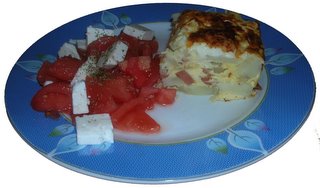
Ingredients:
Here's a recipe that I've just invented as a present for a banana-lover. :D Ingredients: This cake tastes good, but is a bit heavy, so it's better served as a snack, or after a light meal.
If you're on a diet, you'd better skip this page. :P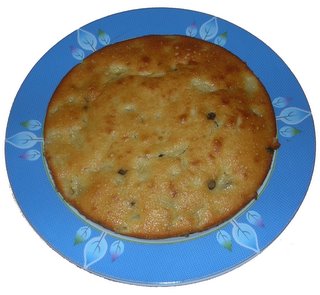
One common Greek food is "bifteki"... the Greek version for "beef steak". There are many ways to adapt this easy recipe (you can easily change the herbs, spices and proportions, according to your taste). Ingredients (for 6 steaks):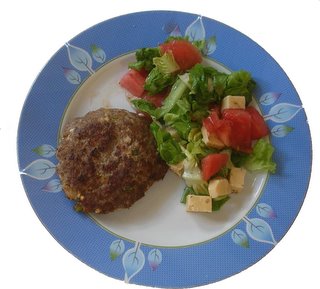
This is a nice summer food that can be served with a light salad.
The word caramel has a latine root (it comes from caramellus: "sugar cane"). Toffee is quite similar but needs butter. I'll explain here the basic principles to make caramel - you can use those principles to make thousands of different caramels ! To make toffee, you can add butter, cream, milk, nuts and chocolate to your caramel. Liquid caramel can be used as a coat for cakes (ex: Semolina Cake). For covering choux à la crème or fixing together pieces of pastries, it's better to use a very light and liquid caramel.
Ingredients:
This is my own adaptation of a common recipe. You can add raisins in the mixture before baking the care, and cover it with Grand Marnier instead of the caramel layer.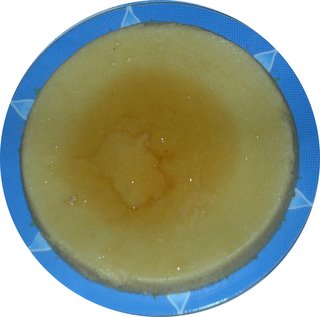
Ingredients:
Crêpes are definitely amongst the most famous French foods. It can be eaten as a main dish or as a dessert, and be filled with many various ingredients - everybody likes it ! Crêpes are a great symbol in the French imagination: it's believed that if you make them "jump" on Chandeleur (2nd of February, commemorating the Presentation of Jesus at the Temple), with a coin in your hand, you'll be rich for all the year on. We also prepare crêpes for Mardi Gras (literally "Fat Tuesday" - better known as Carnival, the last day before the Fast period) and have a famous melody : "Mardi Gras, t'en va pas, J'f'rons des crêpes, J'f'rons des crêpes, Mardis Gras, t'en va pas, J'f'rons des crèpes et t'en auras!" If you didn't use sugar for the paste, you can put eggs, bacon and cheese on your crêpes and serve it as a main dish. For dessert ones, use your imagination: sugar, jam, chestnut cream, chocolate, chantilly, fruits, ice-cream, etc ...
In Bretagne (Brittany), for the main dish crêpes, they use whole flour instead of all-purpouse flour, and drink cider with those crêpes.
Ingredients:
This is a really easy recipe, and this kind of cake will be enjoyed on all occasions. :)
Ingredients:
This chocolate cake can be served with a bit of cream and decorated with chocolate chips, or accompanied with ice cream, or topped with fluffy vanilla. The taste also matches well with a glass of milk (for breakfast...).
The Chantilly cream is a more modern version of the whipped cream (highly enjoyed and advertised by the king Louis XIV). It's said to have been created for the first time in the city of Chantilly, in Picardie. Whip the cream continuously until it gets the thickness of a whipped cream. Add the sugar and the vanilla (it's important to use superfine sugar). Whisk again. It's ready. Keep the Chantilly refrigerated. Can be used to cover a Strawberry Genoise Cake.
Ingredients:
Génoise has been name after the Italian town Genoa, where this biscuit recipe comes from. Idea of recipe using génoise: Strawberry Genoise Cake
It can be used alone as a snack with jam, or as a base for cakes.
Ingredients:
Pastry Cream, Crème Patissière, is the basis of almost all French pastries. So it's one of the most important recipes for cooking deserts. This pastry cream can be used in a Strawberry Genoise Cake
Ingredients:
Génoise is the name of the biscuit on which the cake is based. For the pastry cream (crème patissière): For the Chantilly (1/4 L): Others:
I elaborated this recipe for a birthday (using "basis" such as génoise, pastry cream, and chantilly).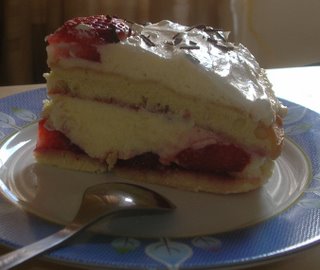
Ingredients:
For the génoise:
The term sushi is used for many kinds of bite-sized pieces of vinegared, most commonly topped with fish, or rolled in nori. For the dressing: Vinegar sauce: bring together the vinegar, sugar and soy sauce, and heat slowly for the sugar to melt Don't forget first to wet your hands (keep a bowl of water close by, because your hands always need to be wet while confectioning sushi - as well as the knives that you may use to cut the fish) - a slice of raw fish (cut the fish in such a way that its size fits with the shape of the riceball) Ideas for variations:
Sushi were invented in the early 19th century. Before fish was kept about one year in a marinade before being eaten, while the sushi, often topped with raw fish, has to be extremely fresh.
Ingredients:
For the rice:
For the filling/topping:
For the decoration (optional):
How to prepare the rice:
How to make nigiri-sushi (the well-known shape):
- or some fish eggs
- or some of the minced japanese omelette
You can decorate it with capers, roasted sesame seeds, or small pieces of avocado
How to make maki-sushi (rolled in nori):
Basically, in French, a croûton is a little piece of crusty bread. Of course, it's possible to use different herbs, depending on tastes and dishes with which the croutons served. Exemple: for the Winter Soup with Vegetables, use garlic, parsley and butter; for omelette, use oregano and olive oil, etc
Croûtons can be used in many recipes, and it's a good way not to waste old bread. :)
Ingredients:
This easy-to-make recipe will be particularly appreciated during cold winters, and can be easily adaptated to whatever vegetables you have at home (turnips, etc), and accompanied with herbs.